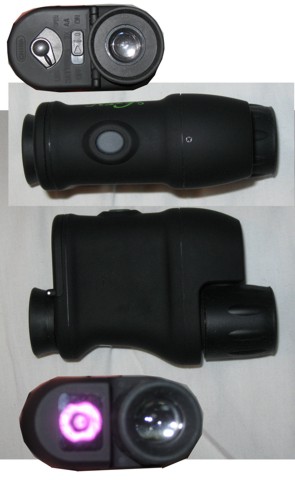
AUNV-TEMPORARY-FORUM
[ main ][ links ][ about ][ help ][ discussions ][ projects ]Digital comes of age. Review and Evaluation of the Digital Xgen monocular.

About 5 years ago, a digital scope came onto the market. It's price was similar to second generation night vision and it made bold claims to be as good as second and third generation night vision devices. For a while, it seemed like Digital technology had finally surpassed tube-based image intensifiers but then the first reviews revealed Digital's fatal weakness – low gain levels put it in a Gen1 class of device. It's inability to give serious levels of light amplification made it unusable for many purposes and to be truly useful it often required active illumination.
Many digital devices have come since then ( and most are still around – it wasn't that long ago ) but to date, they have either lacked performance or been grossly overpriced.
But the the Xgen, recently shown at Shot Show 2012, finally broke through the price limitations, bringing digital into the realm of being truly competative with Gen1. Curious, I picked up a model to give it a try and to evaluate just how far Digital had come.
The Xgen from Night Owl Optics is a completely digital Night Vision device. It uses a low-light CCD camera instead of an image intensifier and displays images on a small screen. Other than that, it has an on-off switch and a mode-change switch that lets you select the operating mode of the unit. The mode is shown on an on-screen display.

It's simple, very small and runs off of three AA batteries. Other than this, it has what would be expected from a small monocular. Eyepiece optics are adjustable for diopter and the objective lens can be focussed for distance. Overall, it's not that different from a number of other NV devices, except the size. The Xgen is perhaps the smallest serious NV device to come out in a digital form factor yet. It's shape is similar to the older ITT Night Enforcer models which makes it convenient to hold and the switches are all well placed. Batteries are field replaceable and the latch is convenient to use – though at first it looks like it's supposed to be the on-off switch so be careful handing such a unit to someone at night switched off, because your batteries may end up on the floor.
Unlike other Digital NV devices, this unit isn't pretentious. It doesn't make claim to be equal to Gen2 or Gen3 and it doesn't pretend it's something it's not. Specifications are basic and reasonable.
Technical data from the booklet that comes with it say;
Model: Xgen
Sensor Resolution: 640x480 pixels
Micro Display Resolution: 320x240 pixels ( QVGA ) *Note 1.
Magnification 2.1x
FOV – 12 degrees.
Range of view at 200 ft – 40ft
minimal Focus Distance – 1M *Note 2.
Eyepiece Adjustment +/- 4D
Battery Requirements: 3 AA Alkaline Batteries ( not included )
Dimensions (IN) 4.8" x 1.65" x 3.10"
Weight: 7oz without batteries
Lens Diameter: 20mm
Infrared Illuminator: Built In.
Includes: Carry Bag, lens cleaning cloth, Instruction manual
There are other specifications around the manual and box also – these include;
"Designed for viewing out to a distance of 70 yards with the assistance of a powerful built-in infrared illuminator"
and mode operational details for five modes of operation such as;
1/3 power IR, 30 FPS ( default power-on mode )
Full power IR, 30 FPS
1/2 power IR, 15 FPS
Full pwoer IR, 15 FPS
Full power IR, 8 fps
It also comes with some basic warnings, one quite valid;
Caution: Do not point infrared emitter directly into eye at close range
So at this point, it's not really promising much. Then according to the box, two further details: The main lens is 26mm focal distance and the IR illuminator is 1W maximum power – quite reasonable for a small unit.
The final details pertinent to this unit is the price. The RRP on these devices is $150 – way below most Gen1 out on the market. Also, the street price can be as low as $122.
Now to review and evaluate it.
Operating the unit is simple. Flick the switch on the back and two seconds later, you have an image. The switch is flat and operated by contact friction with a sliding motion, but is easy enough to engage. It actually isolates the batteries, so unlike some other models, I don't expect any leakage to cause batteries to go flat. The three batteries go in at an angle and the battery cover latch looks more like the power switch which will cause problems for some. However it seems to be a good design that is designed to keep at least a little weather out and appears to seal well enough.
Focus of the lenses is pretty usual but the front lenscap is useless. It fits poorly and the only saving grace is that tie points exist to tie it to the monocular – string not provided. It's important too, because the lenses look to be plastic. The next issue with the lenses is the objective lens which does not cope well with veilling glare at all – in fact a bright light anywhere near the lens axis will seriously screw up the image and causes multiple reflections – part poor lens design and part a lack of any coatings.
The eyepiece lens is small – about 10mm though the eyecup is fine and works well enough for holding up to your eye. Mine also had a dark side, which suggests an obstruction in the lens somewhere though it doesn't seem to affect operation at all so can be ignored.
When it's turned on, the IR comes on immediately. It does not remember which mode it was last used in and switches back to mode one on every power up. That's fine, but a bigger problem is that the IR is ALWAYS on. More on that later.
Turing it on and walking into a dark area with the IR covered up immediately highlights the deficiency of all passive NV devices – it has Gen1 level gain. It's OK on a full moon night, but as less moonlight is available, expect the performance of the device to diminish quickly. That said, the gain of this unit is actually better than average and on my NV tester high-light setting, it easily outperformed a Bushnell Stealthview ( Similar to a Yukon Digital Ranger in performance ) and gave exceptional results on the 8FPS setting and acceptable results on the 15FPS setting while failing to collect enough light for the 30 FPS setting.
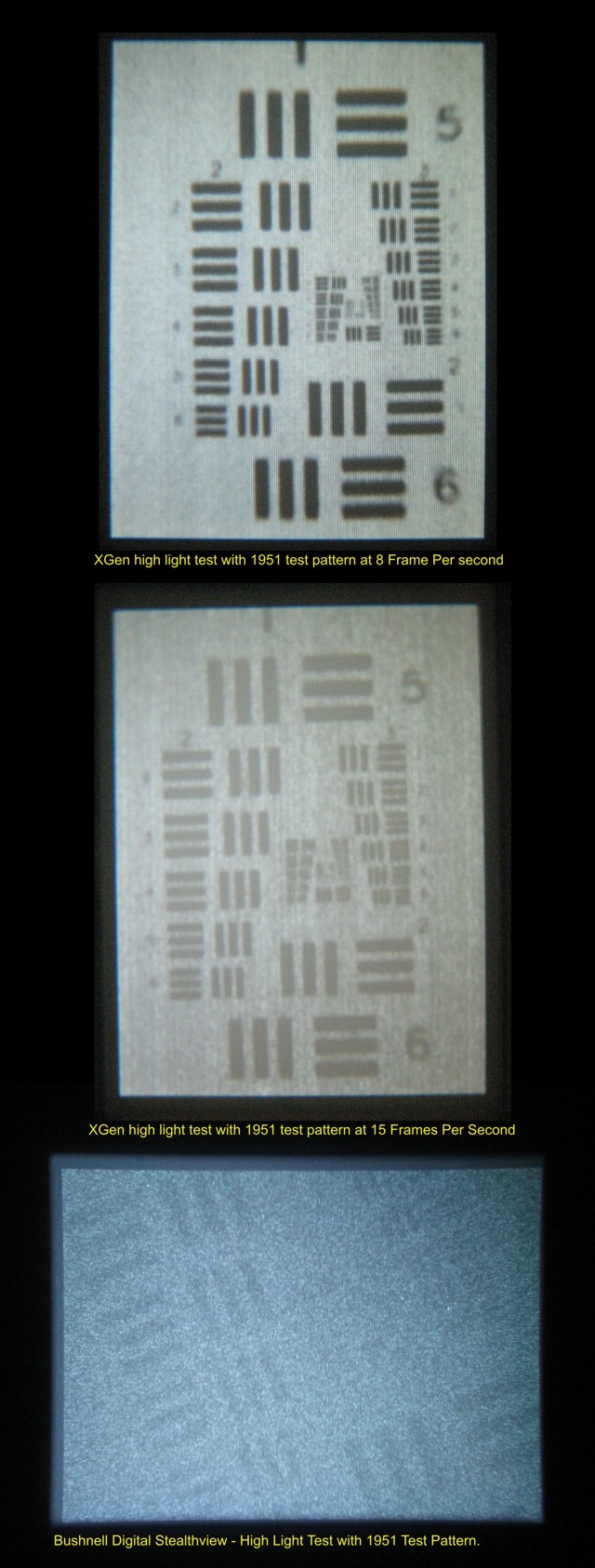
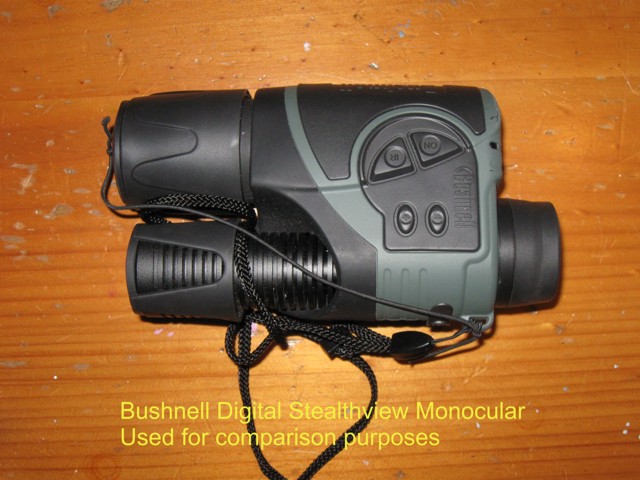
That's something important to note, because that's how this device works – by reducing the frame rate so that the CCD element that drives the system can collect more light.
On the other hand the Bushnell digital model struggled to give a reasonable image at all and has no mode adjustment.
Outside, things were pretty good, but another weakness was found. The screen automatically adjusts for brightness, unlike models such as the Bushnell which allow for user settings of brightness.
With the Xgen, near-field IR reflection causes the brightness to drop too far, leading to far-field objects being too dim to see. This is sad, because often if the near-field reflections could be removed, the far-field objects were quite visible – a serious flaw in a Night Vision device, though on the other hand, it's ability to adjust to most light situations may help some beginners.
Range is about 70yds or perhaps a little past this, so the specifications were correct about that. On the other hand they were no correct about screen resolution ( measured screen resolution on this model was 300 x 224 – WAY less than the 320x240 quoted ) and the Min focal distance ( on this model, it was about 30cm, which was a BIG improvement on the quoted 1m min distance and makes it quite useful for looking at objects close up )
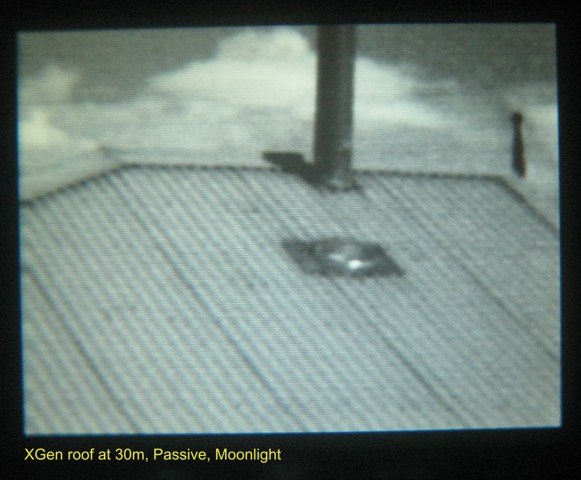
It's a shame about the display because 320x240 isn't bad, but 300x224 is a poor match to the camera and makes the 640x480 incoming resolution even worse.
The screen is a little bright and cannot be adjusted, but not ridiculously bright. It will destroy your natural night vision and will even project an image on a nearby wall, but the small eyepiece makes it less of an issue.
In operation, watching static images, the Xgen gave a good image, even at 8fps, but at 8 frames per second, panning the camera was not possible without the image skewing badly. Generally, the higher FPS modes were fine around urban areas however.
Frame and IR illumination levels are shown onscreen for a few seconds after each mode change. The mode button located on top of the unit changes mode once per press and will cycle through the available modes. The OSD ( On Screen Display ) also shows a low battery icon if your batteries are low and it's quite common about the time that the IR starts to switch off automatically.
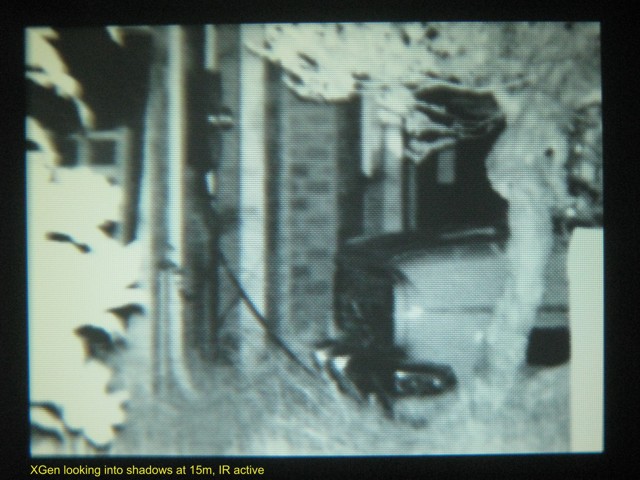
Now, about the IR light. It's bright. At 1w, it will throw light 70 yds without problem, however you can't turn it off and if it's looking straight at you, you will see it. It's not covert and in many circumstances, isn't actually needed, which means that not being able to turn it off is a problem.
It also sucks about 250mA fromt he batteries, so doesn't last very long – I think mine ran about 2 to 3 hours from a single set of batteries before they ran out of power at which point a strange thing happened – the IR turned off and the passive mode became the only option – with running time totalling approximately 10 hours before the unit shut itself down due to low power. So the device has some very nice low-power modes that are ruined by an IR light you cannot turn off. At least one mode of OFF with 8Hz would have been useful and when it does turn off, battery life is exceptional. This is a serious problem that could have been a great selling feature if they got it right.
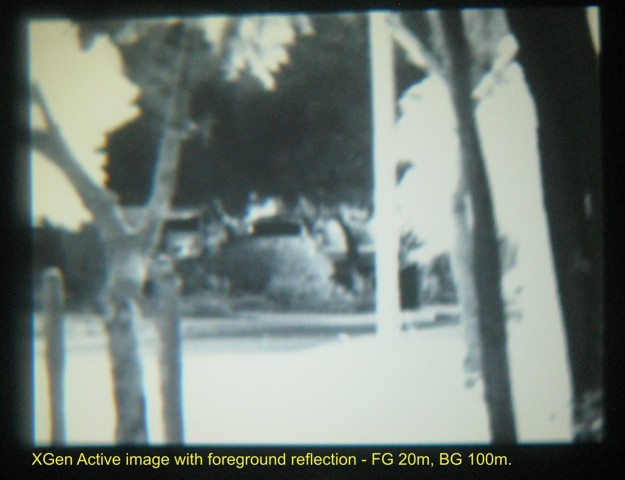

The IR output seems, from my measurements, to be centered around 840nm with most of it's brightness between 810 and 870nm and diminishing until it's not really visible at all below 750nm. Not quite covert but certainly a good choice for this unit.
The other function lacking is any form of output other than the display. With a half-decent digital camera module, this is rather sad because if they included some basic video recording functions, it could be quite a decent night camera – especially with a USB output.
It also comes with a reasonable pouch that can be attached to your belt if necessary -nothing special but it does work.
Now, overall, my opinion.
I think it's a great unit. Don't get me wrong – Gen1 is almost a toy for most purposes and this Digital model is no better than most Gen1's however it's not affected by light and isn't likely to break if someone turns it on during the day, so for most use, it's more practical than Gen1.
2.1x magnification is a good number. It's just enough to make it useful without killing the FOV which is a real problem with Digital.
Sure, it had heaps of problems and these all detract from the overall device, but at the price?
At around $122 as a street price, it's hit the right price point even with it's deficiencies. For anyone who cannot afford serious NV ( by which I mean Gen2 or Gen3 ) then this unit is worth trying out – because even if the value of the unit is lost, it's not much. And with a 1W IR illuminator? It's still pretty good value.
It does work exceptionally well with other illuminators too, so if you have something more covert, then some duct tape can be used to mask the IR output ( or if the near-field reflections from the built-in illuminator are too much ).
Overall, I'm impressed. It won't replace any serious NV devices and isn't useful from a covert perspective without some duct tape, but for something the kids can use? For something that won't be damaged by bright lights? For quickly examining any infra-red light sources? For use around the house where covertness isn't a requirement? For spotting eyeshine out in the fields? For just about anything you can use Gen1 for? It's actually pretty useful.
And like I said, it has a good wide illuminator – which may even be useful if you have some Gen2 or Gen3 devices.
It's been a long time since I found a low-end NV product I thought was worth it's price. The Xgen however met my expectations. Don't expect too much and don't even thing of expecting something that competes with Gen2 or Gen3 and you'll be happy with it I think.
And for a digital, it stands head and shoulders above some of it's better respected peers. And that's something I can respect.
Regards
David
----
Notes - For those taking part in projects with the Xgen, here are the exploded views -
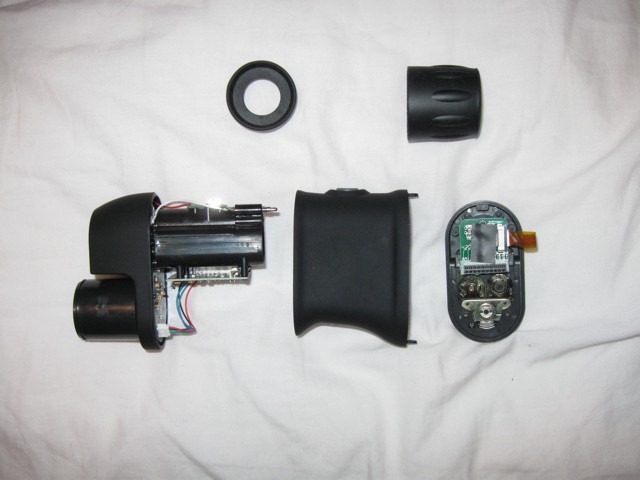
You'll notice I have the cover backwards and the rear plate upside down... But that's an Xgen. To take it apart, remove four screws from the front of the case ( objective lens end ) - two of them are under rubber plugs that will need to be removed with a needle-sized-screwdriver blade. Or perhaps needle. Then open the battery cover and take the batteries out. Remove the two visible screws. Now pull the front from the back. Done.
To remove the ocular circuit ( screen ) you will have to remove the two plugs - same as with the front, then it will come clear too. Both must be removed before drilling the case if you're putting mount points in.
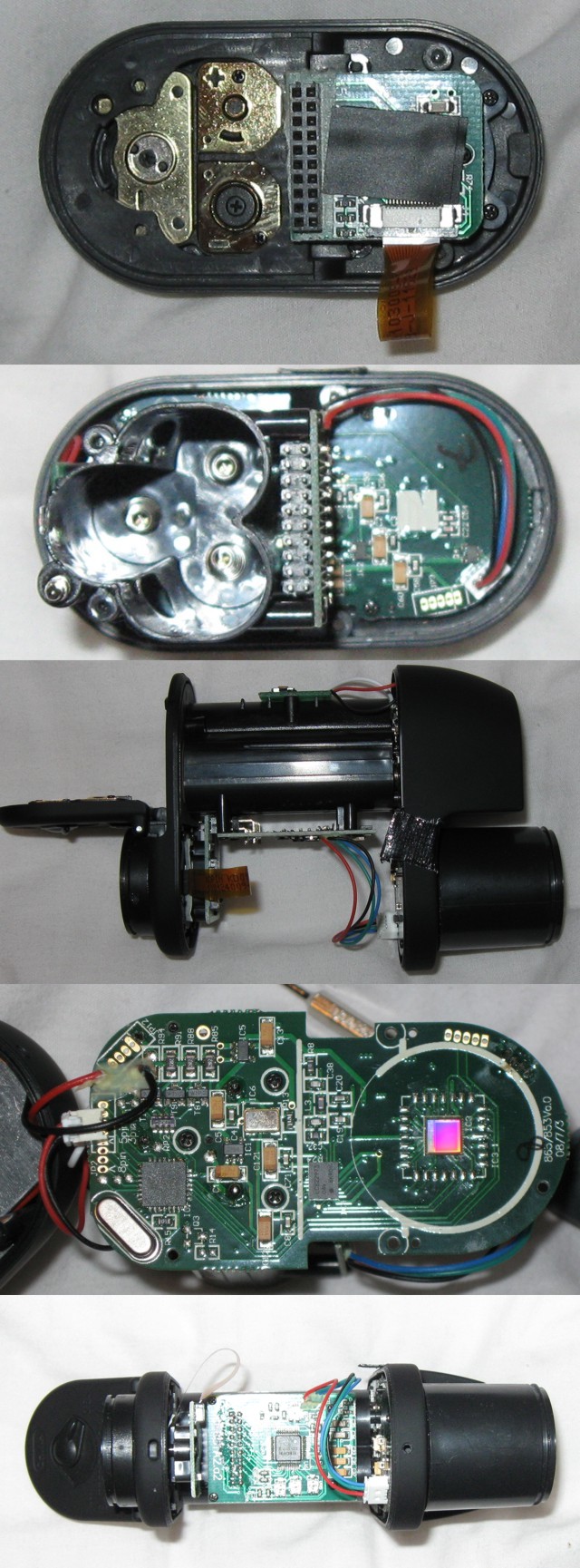
Top to bottom:
1.Ocular circuit.
2. Battery and Camera Circuit
3. Assembled with the main cover removed ( and running )
4. The hidden side of the objective ( camera ) circuit. Four screws need to be taken out. Note the soldered wires going to the IR?
5. The Screen Drive circuit. Some pots there. I didn't play with them.
It would be possible to make a VERY short digital add-on - that fit within the usual eye-relief space of a dayscope if the screen was moved to where the camera circuit sits, separated by a small amount.